The Benefits of Being Multilingual: How Multilingual Learning Leads to $30 Billion Economic Growth
Patty Chavez2024-04-24T14:51:03-07:00
With reports indicating that in California 60% of children under the age of five have at least one parent who speaks a language other than English, the need for robust Multilingual Learning (MLL) programs has never been clearer. This growing linguistic diversity, coupled with the increasing globalization of our economy and society, underscores the critical importance of fostering multilingualism across the state. Beyond the sheer necessity for multilingual learning programs in California, there are proven benefits of being multilingual, spanning from academic achievement to cross-cultural understanding.
In this article, we’ll be overviewing the numerous benefits of being multilingual, such as:
- The rising multilingual landscape in California
- Educational benefits of being multilingual
- Economic benefits of being multilingual
- Social and cultural impacts of being multilingual
- SEAL’s approach to multilingualism in the classroom
At SEAL (Sobrato Early Academic Language), we merge powerful research and an evidence-based approach to advancing the educational outcomes of multilingual learners. We work across the state of California, partnering with preschools and elementary schools, districts, county offices and other educational stakeholders to ensure all English Learners and Dual Language Learners alike can engage in rigorous and joyful learning.
To learn more about SEAL, you can see our resources, contact us for more information, or subscribe to our newsletter for updates.
The Rising Multilingual Landscape in California
California’s demographic landscape is incredibly diverse, with the state being home to nearly a quarter of the nation’s foreign-born population. As the multilingual population continues to grow, and conversations regarding dual-language and multilingualism are more available in recent discourse, the perception of multilingualism has undergone a significant transformation in California.
Reflecting the changing attitudes towards multilingualism, there has been a notable increase in the number of Multilingual Learning (MLL) programs across California’s educational institutions, aiming to better service multilingual children who represent 40% of the state’s public-school enrollment.
In 2021, California allocated $10 million to expanding multilingual program offerings in schools, aiming for more accessible and higher quality multilingual education for California students. Furthermore, the California English Learner Roadmap program and Assembly Bill 1363 are both efforts to establish strategic and productive processes for identifying and enhancing multilingual education.
At SEAL, our impact spans over 50,000 students and trained 1,600 teachers, providing multilingual learners with an educational environment that respects and builds upon their linguistic and cultural assets. Our evidence-based and research-backed approach aims to close opportunity gaps and ensure that students can achieve their full potential.
To learn more about how we are at the forefront of multilingual education programs, you can see the SEAL approach, student outcomes, and educator practice stemming from our work.
Educational Benefits of Being Multilingual
The advantages of multilingualism extend far beyond the ability to communicate in more than one language; they play a critical role in educational development and success. Some specific ways that multilingualism impacts education include cognitive advantages, academic achievement, and socio-emotional development.
Cognitive Advantages
Multilingual students display enhanced cognitive flexibility, showcasing superior skills in problem-solving, creativity, and multitasking:
- Enhanced Problem-Solving Skills: Multilingual individuals often exhibit superior problem-solving capabilities. This is attributed to their ability to approach challenges from multiple perspectives, a skill developed through navigating and processing information in different languages.
- Improved Cognitive Flexibility: Being multilingual has been linked to greater cognitive flexibility—the ability to switch between tasks or thought processes quickly and effectively. This flexibility extends beyond linguistic tasks to general cognitive processes.
- Multitasking: A 2015 study, “Bilingualism as a Model for Multitasking,” shows that multilingual students are better at multitasking, as managing multiple languages equips individuals with the ability to juggle various tasks with less cognitive fatigue compared to monolinguals.
- Delayed Onset Dementia: Being bilingual or multilingual can delay the onset of dementia and other cognitive decline related to aging. A 2020 UCLA Neurology study found that dual language individuals could delay dementia symptoms by approximately four years compared to single language individuals.
Academic Achievement
The long-term educational benefits of being multilingual extend beyond primary and secondary education. Multilingual students can be more likely to pursue higher education and have a broader range of opportunities available to them, including scholarships and programs that value linguistic diversity. Additionally, the skills gained through multilingual education, such as cultural competency and adaptability, are highly valued in college admissions and the workforce.
Multilingual education programs, as advocated by California’s policies and initiatives, have been shown to enhance literacy rates and overall academic performance among students. These programs leverage the cognitive benefits of multilingualism, such as improved memory and attention, to support academic learning. For example, students in dual-language immersion programs often outperform their monolingual peers in reading and writing assessments, not only in their second language but also in their native language.
Multilingual learning programs can substantially aid in closing the achievement gap for English Learners (ELs) and Dual Language Learners (DLLs). According to a 2023 policy brief on multilingual learning in CA, ELs and DLLs in multilingual programs often catch up to or surpass their peers in monolingual programs, particularly in areas of math and reading comprehension. By providing instruction in both the student’s home language and English, these programs enable students to build upon their existing language skills while acquiring new ones, leading to better academic outcomes across subjects.
Socio-Emotional Development
For many students, particularly those from non-English-speaking households, the ability to learn in and switch between multiple languages reinforces a positive sense of identity and self-esteem. Programs like SEAL, which value and incorporate students’ home languages and cultures into the curriculum, affirm students’ backgrounds, helping them feel valued and understood within the educational system. This validation is crucial for socio-emotional well-being, as it encourages a sense of belonging and pride in their cultural heritage.
Education that emphasizes culturally-rich and diverse understandings requires cooperative learning strategies, collaborative efforts, and positive and nuanced definitions of identity both in and out of the classroom. Multilingual education programs, therefore, are not just about acquiring communication skills; they naturally cultivate socio-emotional skills by integrating cultural studies and real-world applications of language learning.
Economic Benefits of Being Multilingual
The job market and greater economy showcase the substantial economic benefits of multilingualism, including higher earnings, increased demand in the job market, and a pivotal role in economic mobility and poverty reduction.
The Need for Multilingual Programs
In a 2023 policy brief from the Bay Area Council Economic Institute, they found non-English-speaking households could earn significantly more if they possessed bilingual skills. On average, bilingual households have the potential to earn $30 billion more collectively, or $15,519 more per household annually. This data underscores the tangible financial advantage of being bilingual, positioning multilingualism as a valuable asset in the workforce.
Furthermore, the brief notes that from 2010 to 2023, job postings in California requiring bilingual skills nearly quadrupled, making up 68% of all bilingual job listings across the U.S. The healthcare industry, in particular, shows a remarkable demand for bilingual professionals, accounting for 43% of total bilingual postings in the state.
In a report on the economic benefits of multilingual learning, researchers discovered key findings on the economic limitations multilingual students face due to lack of educational support for multilingual learners:
- About 60% of children under five in California have at least one parent who speaks a language other than English.
- These children are 160% more likely to live under the poverty level compared to their peers with English-only speaking parents.
- Non-English speaking households could earn $30 billion more collectively, or $15,519 more per household, if they had earnings comparable to their bilingual counterparts.
California has a unique opportunity to leverage its multilingual population to foster economic growth, improve educational outcomes, and enhance societal integration. By providing these individuals with the tools and opportunities to become bilingual, there is a clear pathway toward economic improvement and poverty alleviation, with median earnings for bilingual households being $100,000 higher than for households that do not speak English.
How Multilingualism Positively Affects the Economy
Multilingual skills not only open doors to higher-paying jobs but also contribute to broader economic mobility, enabling families to access better education, healthcare, and housing opportunities. Current job market trends show an increased need for multilingual employees, suggesting that promoting effective, research-backed multilingual programs can have an impact both on individual students and the greater economy:
- Growth in Bilingual Job Postings: From 2010 to 2020, job postings requiring bilingual skills in California increased from 22,996 to 96,714.
- Bilingual Job Postings as a Percentage of Total: The share of job postings requesting bilingual skills rose from 1.1% in 2010 to nearly 2% in 2020.
- Industries and Occupations: The healthcare sector dominates bilingual job postings, accounting for over 25% of such postings in California. Registered nurses are the top occupation with bilingual postings, making up 13% of the total.
The expansion of multilingual programs across California can harness the economic and educational benefits of multilingualism. SEAL recognizes the significant economic benefits of multilingualism as well as the need for supporting multilingual learners in the classroom. Our approach subsequently lays a strong foundation in the early educational stages.
You can read the full report to learn more about the economic benefits of being multilingual, or look through our resources for more research.
Social and Cultural Benefits of Being Multilingual
There are numerous socio-cultural benefits to being multilingual, including:
- Enhanced Communication Skills: Multilingual individuals can communicate with a broader range of people, fostering more inclusive social interactions and relationships.
- Community Building: Multilingual individuals can act as bridges between different linguistic and cultural communities, promoting unity and mutual understanding.
- Cultural Preservation: Multilingualism plays a crucial role in the preservation of minority and indigenous languages and cultures, contributing to the diversity and richness of global cultural heritage.
- Global Perspective: Being multilingual fosters a global perspective, encouraging individuals to think beyond their local context and understand global issues and trends from multiple cultural viewpoints.
- Increased Cultural Sensitivity: Exposure to multiple languages often comes with exposure to the cultures associated with those languages, leading to heightened cultural awareness and sensitivity. This can improve interpersonal relationships and facilitate better understanding and cooperation among people from diverse backgrounds.
Despite the common misconception that exposure to multiple languages in infancy can complicate language and cognitive development, studies show that having exposure to multilingualism at an early age helps children be more open to new language learning, fostering curiosity and a positive approach to linguistic and language diversity.
Multilingual education fosters inclusive communities where linguistic and cultural diversity is celebrated, creating environments that encourage mutual respect and understanding. The collaborative nature of multilingual education, particularly as seen in California’s community schools, supports not just academic achievement but also social integration and community engagement. Promoting dual language or multilingual learning can help students feel more comfortable and confident in connecting family traditions and histories to their education, as well as celebrating their own self-concept and identity.
For instance, Redwood City School District’s Adelante Selby Spanish Immersion program demonstrates how bilingualism can be a superpower, enabling students to finish their elementary education fluent in both Spanish and English, celebrating and reflecting the values of their diverse linguistic communities.
Educational programs which nurture multilingualism significantly enhance social integration and contribute to the formation of a society that values diversity, mutual respect, and understanding. By emphasizing socio-emotional development and family engagement, such educational frameworks not only aim for academic proficiency but also the development of well-rounded, empathetic individuals.
SEAL’s Approach to Multilingualism in the Classroom
For more than 15 years, SEAL has worked across California partnering with preschools, elementary schools, districts, county offices and other educational stakeholders to ensure California’s culturally and linguistically diverse children thrive. This includes support for all students—from Pre-K to advanced Multilingual Learners.
The SEAL approach is based on the fundamental understanding that multilingual learners should be provided an education that fosters their growth, so that they can experience the benefits of their multilingual capabilities in the short and long term. By focusing on joyful and hands-on learning, our approach cultivates confidence and engagement for students throughout their learning journey.
These approaches meet the language demands of each grade level, merging the best practices for English Learners, Dual Language, and Multilingual Learners with strategies that advance greater facilities for learning for our students.
Our approach revolves around four fundamental pillars.
- Integration of Expressive Academic Language: We emphasize embedding rich, expressive academic language across the curriculum, recognizing the integral role language plays in educational attainment and cognitive development.
- Creation of Culturally-Rich Learning Environments: By fostering learning spaces that welcome and celebrate cultural diversity, the SEAL approach ensures students feel a sense of belonging and acceptance.
- Alignment of Educational Practices: We advocate for the consistent alignment of teaching practices and strategies across grade levels, ensuring a smooth educational journey for students from preschool through elementary education.
- Strengthening Family-School Partnerships: Acknowledging the critical role families play in the educational process, we strive to forge and maintain robust connections between schools and families, enhancing the learning experience and outcomes for students.
SEAL in Action
Our work has aimed to provide abundant and fruitful learning opportunities for multilingual students because we know that the benefits of being multilingual and having a multilingual learning environment can lead to countless positive outcomes.
We were able to see the SEAL approach’s transformative power in the Oak Grove School District, which primarily utilized English Language Development Centers (ELD), segregating English Learners from their peers in language instruction. This approach hindered students’ full participation, ability to collaborate, and feel confident in their learning. After adopting SEAL in 2013, results showed significant improvement in teaching practices, student engagement, and language and academic development among ELs and Dual Language Learners.
A comprehensive study conducted by Loyola Marymount University’s Center for Equity for English Learners (CEEL) and the Wexford Institute, spanning 67 schools across 12 districts between 2015 and 2019, attested to SEAL’s efficacy. The study concluded that the SEAL model significantly improves teaching practices, elevates student engagement, and bolsters language and academic development among multilingual students, illustrating how multilingual learning is vital if students wish to experience the benefits of multilingualism.
Help Students Experience the Benefits of Being Multilingual with SEAL
Through the lens of cognitive development, academic achievement, socio-emotional growth, and economic benefits, it becomes clear that being multilingual is not merely an academic asset—it is a comprehensive life skill that opens doors to myriad opportunities and bridges cultures in our increasingly globalized world.
California’s commitment to supporting multilingualism through educational policies and programs like SEAL is a testament to the state’s recognition of the invaluable role of multilingual programs. As we move forward, it is imperative that these efforts continue to be supported and expanded, ensuring that all students, regardless of their linguistic background, have the opportunity to benefit from the rich, diverse, and inclusive education that multilingual programs offer.
At SEAL, we base our approach on extensive evidence and research to bastion English Learner, Dual Language Learner, and Multilingual Learner communities. To learn more about our work and our efforts to develop more inclusive, empathetic, and effective education programs, you can see resources, case studies, or contact us for more info.

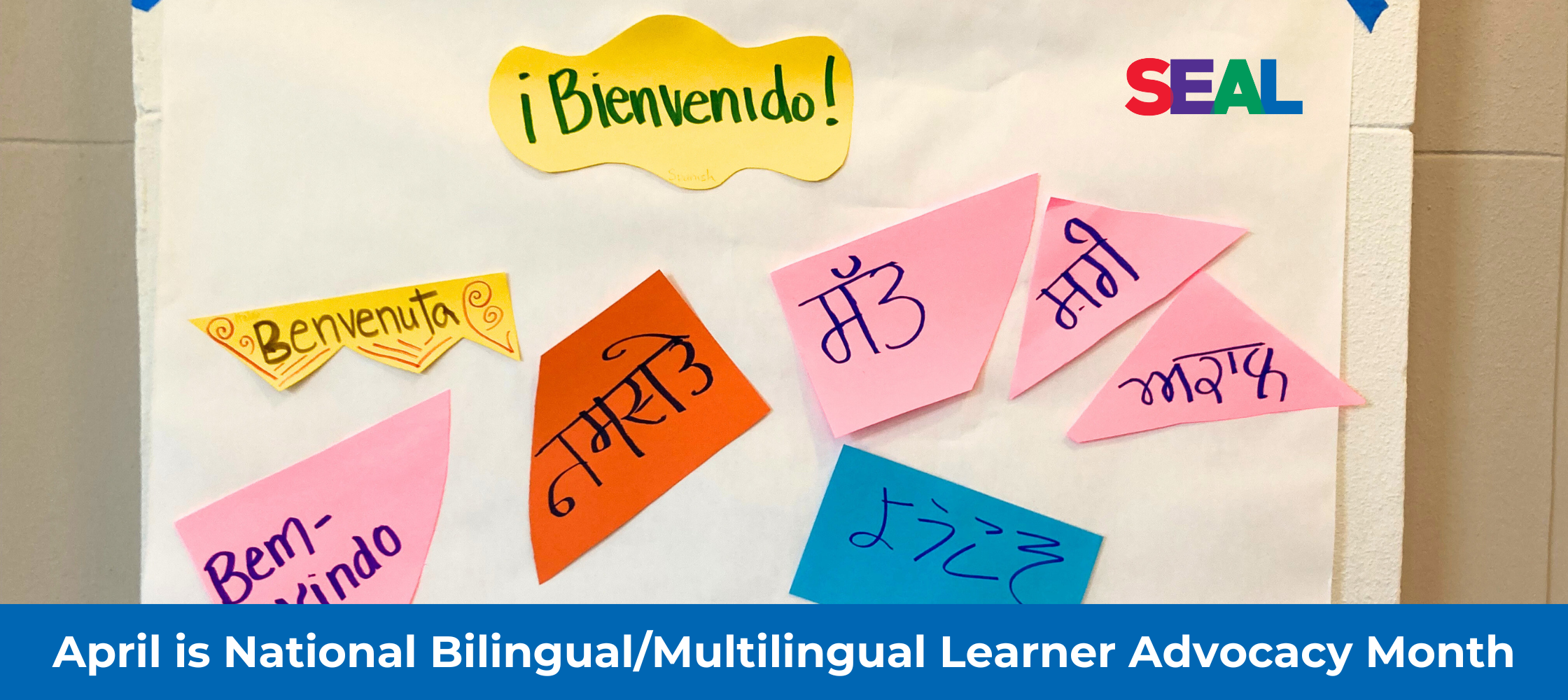
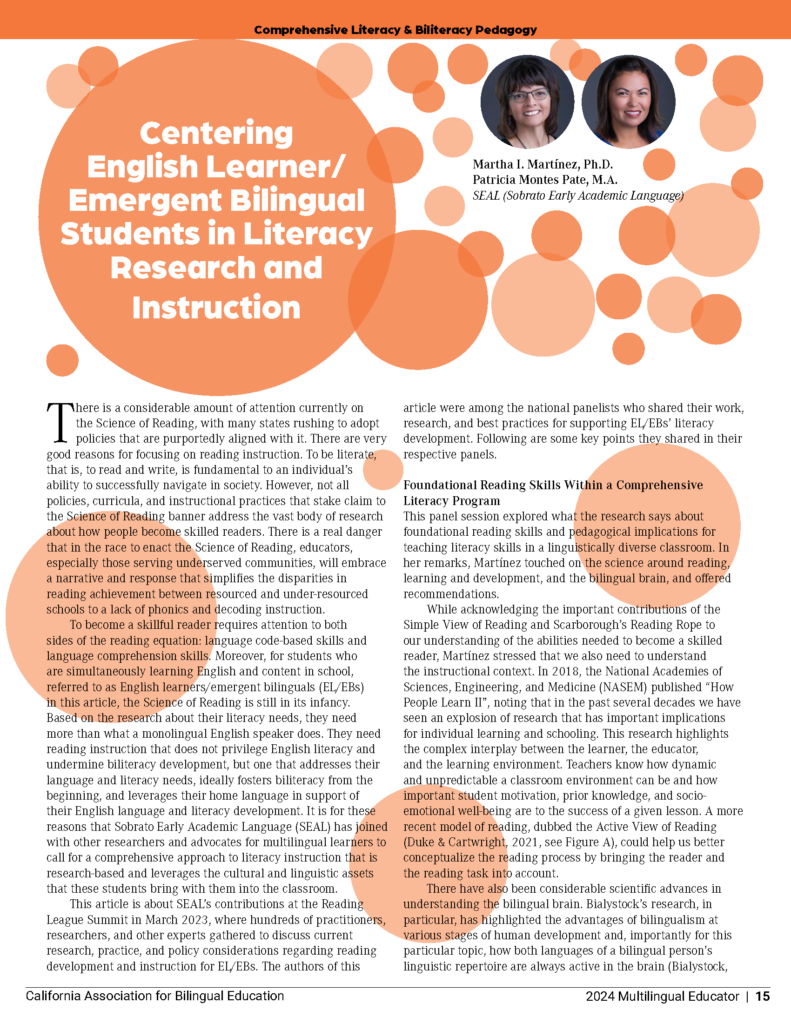 Authored by Dr. Martha Martinez and Patricia Montes Pate from SEAL, this article focuses on SEAL’s contributions at the Reading League Summit in March 2023, where hundreds of practitioners, researchers, and other experts gathered to discuss current research, practice, and policy considerations regarding reading development and instruction for EL/EBs. Our team participated in two panel sessions.
Authored by Dr. Martha Martinez and Patricia Montes Pate from SEAL, this article focuses on SEAL’s contributions at the Reading League Summit in March 2023, where hundreds of practitioners, researchers, and other experts gathered to discuss current research, practice, and policy considerations regarding reading development and instruction for EL/EBs. Our team participated in two panel sessions.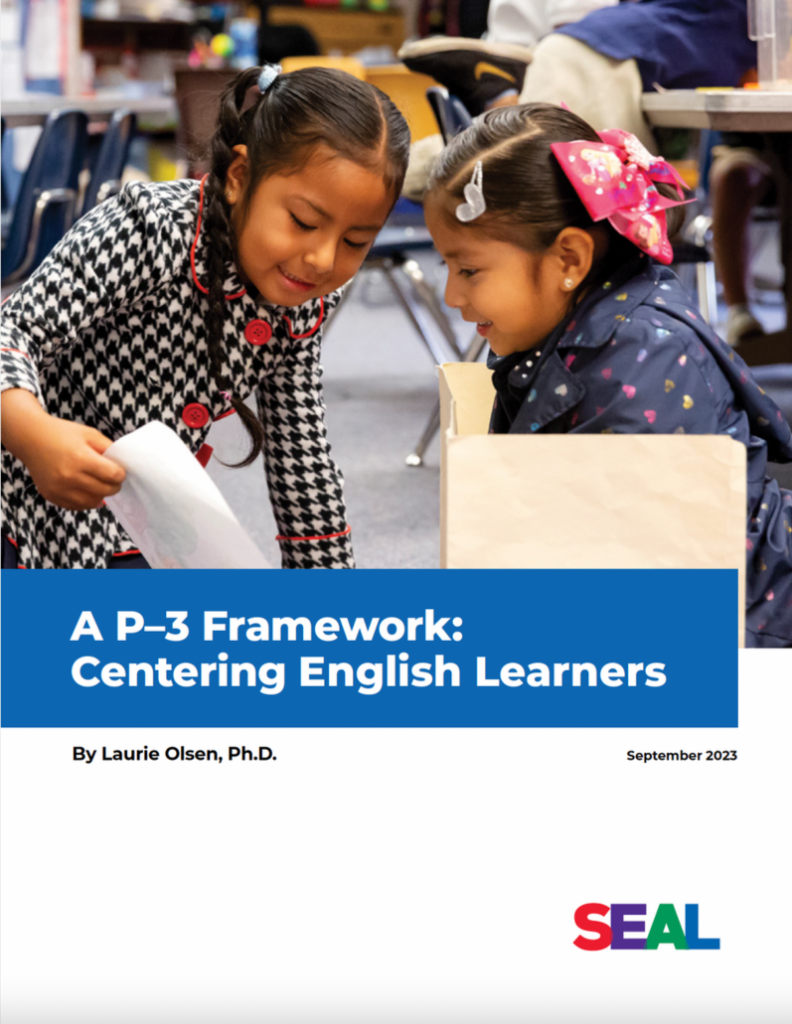 SEAL’s P-3 Framework: Centering English Learners authored by Dr. Laurie Olsen, provides a vision of an inclusive,
SEAL’s P-3 Framework: Centering English Learners authored by Dr. Laurie Olsen, provides a vision of an inclusive, 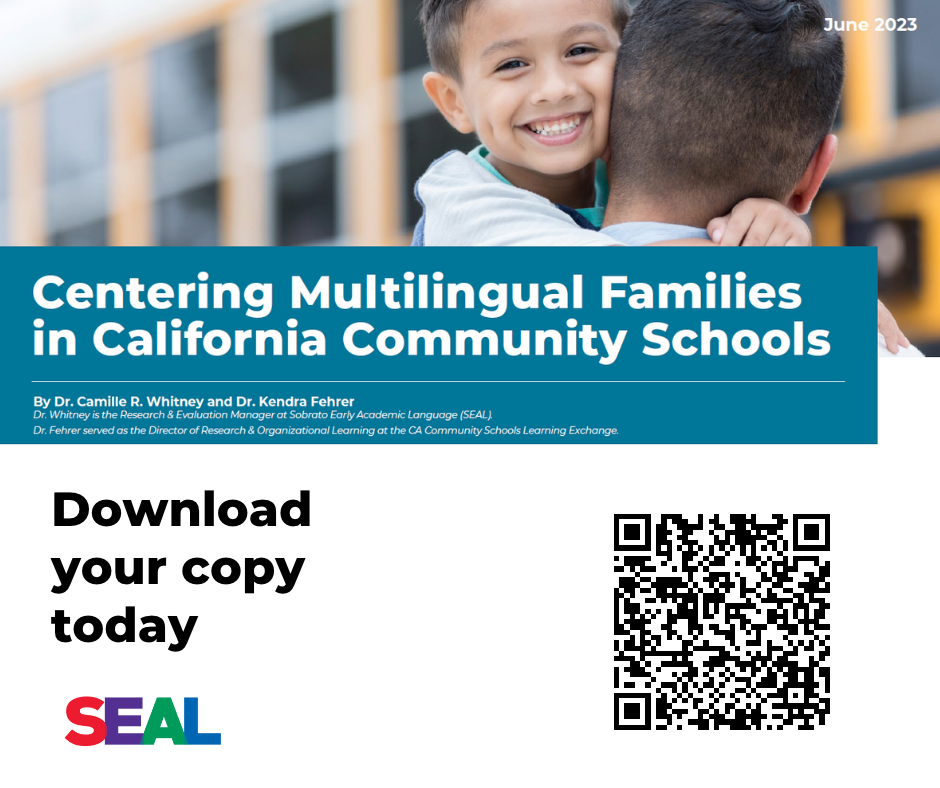 Community schools are schools where resources and voices of the staff, families and community are organized around supporting student success. They have shown promise in improving student learning and well-being, particularly with underserved populations such as Dual Language Learners and English Learners. The brief by SEAL and
Community schools are schools where resources and voices of the staff, families and community are organized around supporting student success. They have shown promise in improving student learning and well-being, particularly with underserved populations such as Dual Language Learners and English Learners. The brief by SEAL and 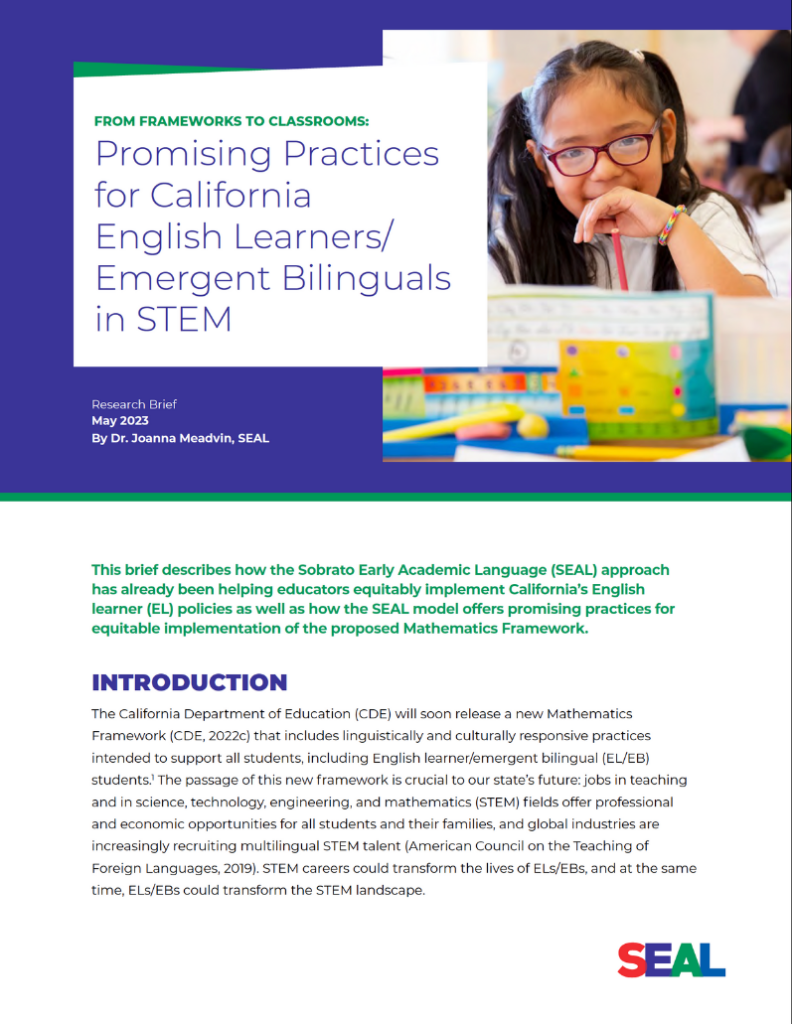 Focuses on research-based guidance from a 2018 National Academies of Science, Engineering, and Medicine (NASEM) report and brings to life how California educators can align the proposed Math Framework policy with the realities of teaching and learning in the classroom. Authored by SEAL Program Manager Dr. Joanna Meadvin, the brief shares how SEAL teachers cultivate inclusive and affirming classroom cultures that celebrate multilingualism as an asset; actively engage with math and science curricular materials, transforming them to be responsive to students’ language and content needs; and provide ELs/EBs with multiple opportunities for rigorous, scaffolded engagement with math and science content.
Focuses on research-based guidance from a 2018 National Academies of Science, Engineering, and Medicine (NASEM) report and brings to life how California educators can align the proposed Math Framework policy with the realities of teaching and learning in the classroom. Authored by SEAL Program Manager Dr. Joanna Meadvin, the brief shares how SEAL teachers cultivate inclusive and affirming classroom cultures that celebrate multilingualism as an asset; actively engage with math and science curricular materials, transforming them to be responsive to students’ language and content needs; and provide ELs/EBs with multiple opportunities for rigorous, scaffolded engagement with math and science content.